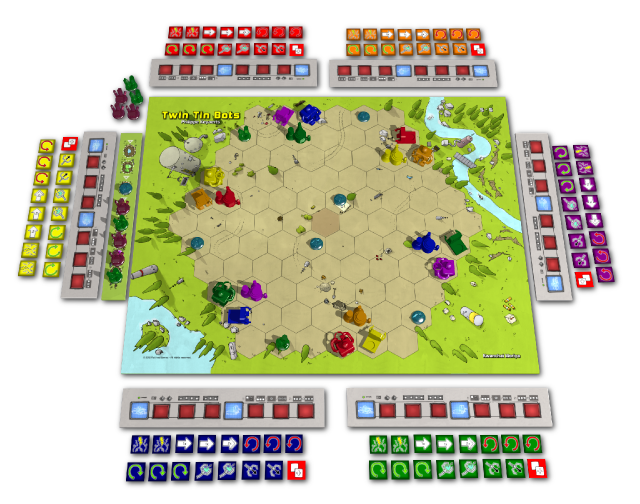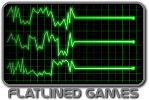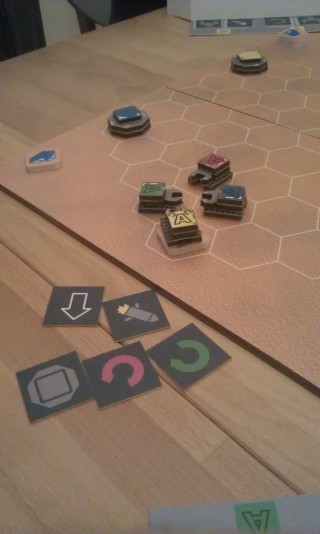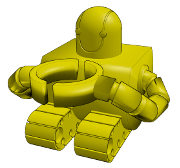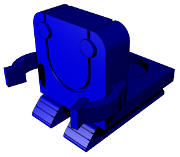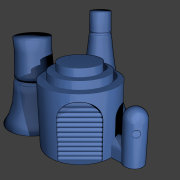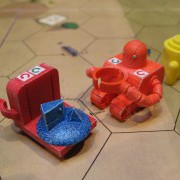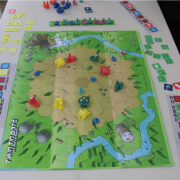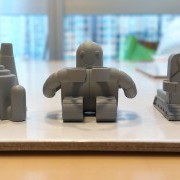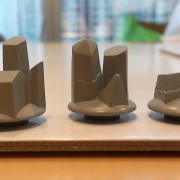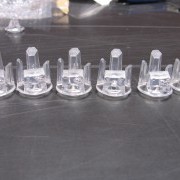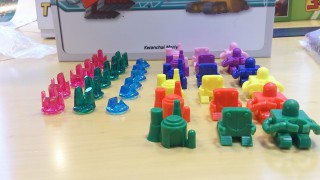
Make sure to check out the first part of this series : Twin tin bots design notes by Philippe Keyaerts.
The making of Twin Tin Bots
Eric Hanuise
1. Game Development
I was lucky to be involved with Twin Tin bots from the very first playtesting session. The prototype was already nice looking, with cute foam-core robots.
The first play was too long, lasting over two hours, but most of the elements worked quite well and I immediately liked that new game we just tried. Over the next few weeks we met for some more playtesting sessions, as the game was refined and developed. The more I played it, the more I liked it, and when Philippe told me the game was now far enough in the development process that he was starting to pitch it to publishers, I told him 'hey, I've loved that game since we started playing it, would you consider letting me publish it ?'
We discussed this for a while, sharing our views on how this prototype could be made into a published board game, and our individual expectations about such a project. We both knew I'm a young publisher, with much more limited resources than a big name publisher, and we both agreed that one key aspect of the game's appeal was to have actual 3d robots and crystals on the game board. Of course the game could be produced using cardboard tokens for the robots and crystals, but it would be much less appealing, fun, and cool. Cardboard standees or cardboard-made 3D robots and crystals were also not enough, it was clear to us that the game required plastic miniatures for the robots and crystals. This meant that if I was to publish Twin Tin Bots it would be a challenge, both financially and technically as I had never produced a game with plastic miniatures before.
We also discussed financing : I knew I could shorten the time required to finance the game production by using crowd-funding, but if we were to go that route I wanted to make sure from the get go that he was confident with that approach, and ready to support the campaign wholeheartedly.
After a few days of pondering, Philippe confirmed to me that he was in agreement, and we promptly signed a publication contract for Twin Tin Bots.
From that point on, the second stage of development started. Twin Tin Bots was already very good and fun to play, but play time needed to be made shorter. One of the key elements that was difficult to fine tune was the player turn order as explained in the design notes. We lost time idling between player turns, not much : 15 to 45 seconds, but for each player on each turn. This added up over the length of a full game to 20-30 minutes, spent waiting instead of playing. We both sensed there was a problem there and were looking for solutions to it. The 'active player' token that players would pass along saying 'beep' when they were done somehow worked but was quite artificial, and some players still forgot to pass it along.
We were both performing as many play-test sessions as we could, testing small changes and tweaks with every session. I also started to showcase the prototype in various events in preparation for the crowd-funding campaign. As I was traveling to Cannes for the yearly international games festival, I got a message from Philippe : he eventually found a way to deal with this, by completely changing the turn order. This changed the dynamics of gameplay a bit but it made up for it by adding a healthy dose of tactical reactivity to the game. I quickly made the required changes to the prototype in the hotel room and went on to play-test it the whole night at the 'off' - a huge open space available to everyone at night when the festival closes its doors. The change proved very good, players liked the game even more, it was shorter to play, with much less downtime.
As development continued, I scrupulously timed all play-test sessions, analyzing what players spent most time doing during the game. We also experimented with different set-ups for the bases and crystals, and honed the design bit by bit. We found out that sometimes players would get stuck between a base and the board limits, so the bases were moved away from the board sides. Also, we experimented with the special order tiles to get a good mix that was fun and balanced. And we prepared a few extras such as the rocks, blobs, teleporters and mud that would be used as incentives for the crowd-funding campaign.
2. Art
The overall look and feel for the finished game was also something we discussed at length early in the project. The initial prototype had an earth/brown board and grey robots, playing the 'space miner' theme fully. Sometimes, players were apprehensive to play-test the game because they found the theme cold or intimidating and feared it would not be a game for them. Once they played it, however, most loved the game, and it was clear the gameplay appealed to a large audience. To give the game the most chances to reach a wide audience, I wanted to make the theme more appealing to casual gamers. Instead of the usual 'grey robots on a barren planet beneath a black starry sky', our robots would work on an earth-like planet, with an atmosphere, vegetation, and a bright blue sky. I asked Kwanchai Moriya whether he was available to illustrate this game, and he gladly accepted the mission.
His first work was to design the bases, gems and robots. It was a challenge as they would later be turned into actual 3D objects, and Philippe and I had decided that the gems and robots had to be designed in a way that they fit together for easy manipulation during gameplay. Kwanchai produced several sketches, some of which can be seen on the game box sides when opened, and we eventually picked two we liked more than the rest.
The crystals also had to clearly have different sizes as they had different point values in the game, and Kwanchai did a wonderful job designing those, and the bases.
I started speaking about the game online, and we launched a small contest to find a good name. We had a few ideas, but none that really stuck, and kept calling it 'the robot game'. Clearly a better name was required! The contest was a hoot and we received over a thousand individual submissions to choose from. We eventually picked the 'Twin Tin Robots' entry from Rodolphe Perrien, which became 'Twin Tin Bots'.
While Kwanchai set to work on the board art, player aids and tiles, I had to turn his sketches of robots, crystals and bases in actual plastic models. I spent some time researching the production of molded plastic parts, and asked a lot of questions to games manufacturers and some other boardgames publishers I knew had experience with plastic parts. I received a ton of info, and decided that I would make 3D computer models of the parts, and then have the manufacturer create molds based on these 3d models. I had learned enough about the process to be aware of what kind of shapes can and cannot easily be molded, so I was careful to design the 3D models in a way that would require the least conversion work by the manufacturer. I created the models using Blender, for both robots, the three crystals sizes and the bases.
One of the very nice perks of having a 3D model of your parts is that you can have a 3D printing company to actually create prototype parts from these models, long before you commit to the huge costs of having a steel injection mold cut to your designs. I had a set of parts printed, and we could check the 3D printed models at actual size to make sure they matched our expectations, that the crystals fit well with the robots, that all parts were easy to manipulate during play, etc. I can tell you there's something a bit magical about getting the printed parts back when you've spent hours creating them from nothing on your computer. Philippe was also very enthusiastic when we got these, as the project was getting more tangible than ever.
As Kwanchai delivered the art for the game, I assembled a few pre-production prototypes using the final art and 3D printed parts. These were used to have some reviewers talk about the game before the crowd-funding campaign, and to promote the game during fairs and events. Every time we placed the components on a table the reception was very good, players loved the cute robots and crystals, and wanted to try the game.
3. Production
We then proceeded to launch the crowd-funding campaign, which also was a first for me. I had some funds set aside for the preproduction of the game : art, prototypes, some promotion, ... but not enough to fund the actual production of the game. This is a big box game, with a ton of components : a big board, more than a hundred counters and tokens, a fat rulebook, and of course the 36 plastic miniatures for the robots, bases and crystals. Costs for creating the molds and producing the game meant we had to produce at least 3.000 copies, for a total cost of several tens of thousands Euros. Flatlined Games doesn't rely on bank loans to produce games and only uses its existing capital for operations. This is a very safe way of doing business, but it also is quite slow and funding the production of Twin Tin Bots without some addition of cash would have required over two years.
I knew Philippe was quite popular in France and Belgium, so I decided to complement the English language Kickstarter campaign by a French language campaign on ulule.fr to make it more accessible to the french speaking fans.
I partnered with Game Salute to get access to Kickstarter, as it was not open to non-US resident project creators at the time. They provided me with a lot of help and insight on how to set up a campaign, as they already had garnered extensive experience on the subject. So I started the campaign... and it fell short of the goal we had set.
We took time to analyse the campaign, and assessed that the lessons from that failure would allow us to make it succeed on a second attempt. So I reworked the whole campaign, building on the lessons learned, and the second attempt eventually was successful. We had a few hundred backers on Kickstarter and Ulule, the game was funded and ready for production.
The next couple months were used to cover all aspects of the game production, get the files and models ready, and line all our ducks in a row. Production went according to schedule and we received the games at the Essen Spiel game fair, just in time for the official release.
I had arranged that the backers who visited the fair could pick up their games on our booth, which quite a few did, and the overall reception proved quite good.
After the fair I started to ship out the boxes to the remaining backers, and to arrange for my distributor Iello to get their orders to the retailers that supported us during the campaign. After that the game was made available to European retailers, and shipped to Iello US which will get them to the US retailers. At the time of this writing (end june 2014), the US boxes have arrived and should reach the retailers very soon.
I have also been contacted by the webmasters of online boardgaming sites boiteajeux.net, boardgamearena.com and yucata.de as they wanted to add Twin Tin Bots to the games they offer on their sites. I gladly agreed, and you can now play Twin Tin Bots in turn-based mode on boiteajeux.net (and soon on yucata.de) and in real time on boardgamearena.com.
The whole adventure took over 2 whole years, from first play-test session to the actual finished game reaching retailer shelves. But there's much more than time and money that we invested in this game, so we really hope you'll like it as much as we do. It was a very special project, unlike the other games I've published. We meet each other quite often so there were very few formal meetings to work on the game or discuss the publication process, most of it was done before or after game nights, in a day-to-day fashion that made the whole experience feel much more like play than work.
